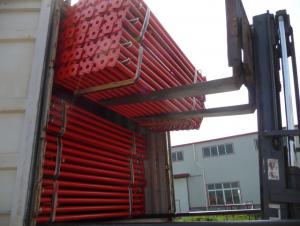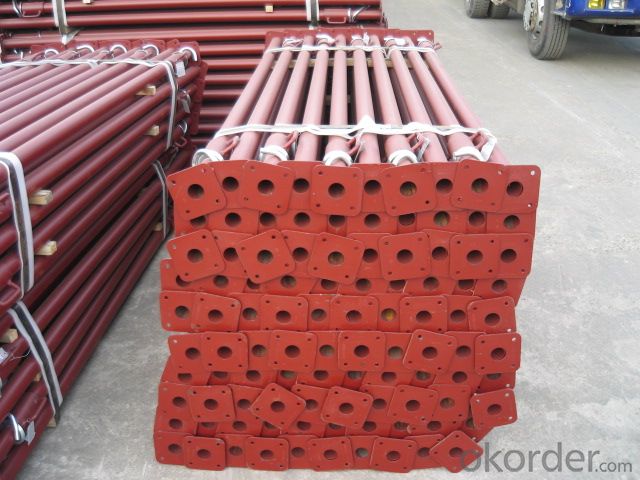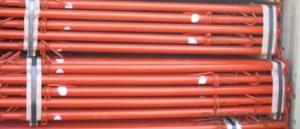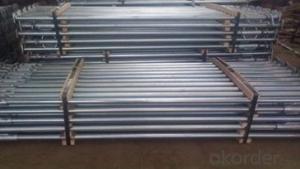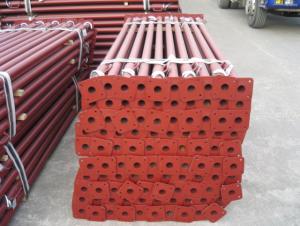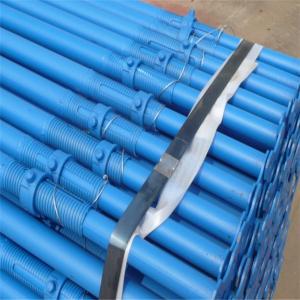Export Adjustable Props /painted surface steel prop 2.2-4M
- Loading Port:
- China Main Port
- Payment Terms:
- TT or LC
- Min Order Qty:
- 1680 Piece/Pieces pc
- Supply Capability:
- 10000 pc/month
OKorder Service Pledge
OKorder Financial Service
You Might Also Like
1. Length 2200-4000mm
2. Outer tube diameter 56mm
3. Inner tube diameter 48mm
4. Tube material : Q235
5. Tube thickness : 3.0mm
6. weight : 16.6kgs
7. square plate : 120*120*4mm
8. Italian type nut
9. G-pin 12
10. Painted surface
11. Color : as customer 's request . red / blue / green / orange/ brown
Packaging & Delivery
| Packaging Details: | packaging :50pcs / bale container : 1680pcs / 20ft |
|---|---|
| Delivery Detail: | 20-30days after receive deposit |
Specifications
Adjustable props / construction prop
Height 2.2-4M
Italy type painted props
Adjustable props
Shoring props
Construction scaffold steel prop
Scaffold props
Telescopic steel props



Product introduce
Steel Prop is a labour and time saving device to support shuttering and centering.
It is made outer tube of 60mm (O. D.) & inner pipe of 48mm (O. D.)
or outer tube 56mm (O.D.) & inner pipe 48mm (O.D.) ,
or outer tube 48mm (O.D.) & inner pipe 40 mm (O.D.) moving in each other telescopically.
The surface has painted , powder , electric galvanized and hot dipped galvanized .
The height use of props by double staging is recommended upto 7000mm only .
Top and bottom plate are provided with nail holes for wooden beam or steel beam .
The top has square shape , flower shape or U-head , U-fork head .
U-head can use fix or adjustable .
- Q: Can steel props be used in seismic areas?
- Yes, steel props can be used in seismic areas, but certain considerations must be taken into account. Steel props are commonly used in construction projects to support temporary structures, such as formwork or scaffolding. In seismic areas, where there is a higher risk of earthquakes, it is essential to ensure that the steel props are designed and installed correctly to withstand the potential shaking and ground motion. To use steel props in seismic areas, engineers must consider factors such as the expected level of seismicity, the building codes and regulations specific to the area, and the structural characteristics of the project. They may need to design the steel props to resist lateral forces and vibrations caused by earthquakes. It is important to note that not all steel props are suitable for seismic areas. Special seismic-resistant designs might be required, including the use of additional bracing or diagonal members to enhance the stability and strength of the props. The material properties, size, and configuration of the steel props should be carefully evaluated to ensure they can withstand the dynamic loads imposed during an earthquake. Additionally, regular inspections and maintenance of the steel props are necessary in seismic areas to detect any signs of damage or fatigue that could compromise their performance. Proper installation techniques, including ensuring adequate anchorage and connections, are crucial to ensure the steel props can effectively resist seismic forces. Overall, while steel props can be used in seismic areas, it is crucial to consult with a qualified engineer who has experience in seismic design to ensure that the props are suitable, properly designed, and correctly installed to withstand the potential effects of earthquakes.
- Q: What are the main considerations when using steel props for supporting formwork?
- When using steel props for supporting formwork, the main considerations include the load-bearing capacity of the props, their height adjustability, stability, and compatibility with the formwork system. Additionally, it is crucial to ensure that the props are installed correctly, with proper bracing and anchoring, to prevent any accidents or structural failures. Regular inspection and maintenance of the props are also important to ensure their continued effectiveness and safety.
- Q: Are steel props suitable for supporting floor slabs?
- Yes, steel props are suitable for supporting floor slabs. Steel props are adjustable and can provide strong and stable support for various types of floor slabs, including concrete slabs. They are commonly used in construction projects to ensure the stability and safety of the floor during construction or renovation.
- Q: Can steel props be used for supporting temporary power generation infrastructure?
- Yes, steel props can be used for supporting temporary power generation infrastructure. Steel props are strong and sturdy, making them suitable for providing reliable support to the heavy equipment and structures associated with power generation. They can be adjusted to different heights and are commonly used in construction and temporary infrastructure projects, including power generation setups.
- Q: Steel braced steel purlin and anchor beam waist connection
- Depending on the distance between the main direction of the water should be fixed, the mainstream water should be encrypted when large. The anchor cable is connected with the joint plate with holes.
- Q: Can steel props be used for temporary support during excavation work?
- Yes, steel props can be used for temporary support during excavation work. Steel props are adjustable and sturdy supports that are commonly used in construction and excavation projects to provide temporary support to structures or areas that require reinforcement. They are typically made of high-quality steel, which makes them strong and durable. During excavation work, steel props can be used to prevent soil movement, cave-ins, or collapses by providing additional support to the sides of the excavation. They can be easily installed and adjusted to different heights and angles, allowing for flexibility in supporting various types of excavation work. Steel props are commonly used in conjunction with other temporary support systems, such as shoring or bracing, to ensure the stability and safety of the excavation site. They are often used in combination with timber or other materials to provide additional reinforcement and prevent any potential hazards. It is important to note that the use of steel props for temporary support during excavation work should be done in accordance with relevant safety regulations and guidelines. Proper installation, regular monitoring, and professional supervision are essential to ensure the effectiveness and safety of steel props in supporting excavation work.
- Q: Can steel props be used for supporting temporary roof structures?
- Yes, steel props can be used for supporting temporary roof structures. Steel props, also known as adjustable props or acrow props, are commonly used in construction and are designed to provide temporary support to various structures, including roofs. They are made of durable and strong steel materials, which make them suitable for withstanding the weight and load of temporary roof structures. Steel props can be easily adjusted to the required height, providing stability and support to the roof structure. They are typically used in conjunction with other temporary support systems such as scaffolding, beams, and bracing to ensure the safety and integrity of the temporary roof. Furthermore, steel props are versatile and can be used in different construction settings, including residential, commercial, and industrial projects. They are commonly utilized during roofing repairs, renovations, or construction works, where temporary support is needed to ensure the stability of the roof structure. However, it is important to follow proper safety guidelines and consult with a qualified professional or structural engineer to determine the appropriate size, quantity, and placement of steel props for supporting temporary roof structures. This will ensure that the temporary roof is adequately supported and meets all necessary safety standards.
- Q: Are steel props resistant to ultraviolet (UV) radiation?
- Ultraviolet (UV) radiation can cause corrosion and degradation in steel props, as they are not inherently resistant to it. However, this issue can be addressed by using protective coatings or finishes that are specifically designed to withstand UV radiation. These coatings create a barrier between the steel surface and the harmful UV rays, thereby minimizing potential damage. It is important to select and apply these protective coatings correctly to ensure maximum durability and resistance. Regular maintenance and inspections are crucial for identifying any signs of deterioration or damage caused by UV radiation and taking necessary measures to prevent further degradation.
- Q: Are steel props environmentally friendly?
- Steel props are not considered environmentally friendly due to their high carbon footprint and energy-intensive production process. Steel production requires significant amounts of energy, releases large amounts of greenhouse gases, and contributes to deforestation and habitat destruction. Additionally, steel props are non-biodegradable, meaning they do not decompose and can contribute to waste accumulation if not properly recycled.
- Q: What are the different types of steel prop pins and clips available?
- There are several different types of steel prop pins and clips available in the market. These include: 1. Drop forged prop pins: These are heavy-duty pins made by the process of drop forging, which involves shaping hot steel into the desired shape. Drop forged prop pins are known for their strength and durability, making them suitable for heavy load-bearing applications. 2. Pressed steel prop pins: These pins are made by pressing steel into the desired shape. They are generally lighter in weight compared to drop forged prop pins but still offer sufficient strength for most construction applications. 3. Adjustable prop pins: These pins feature an adjustable design that allows for height adjustment. They typically have a threaded shaft and a nut that can be tightened or loosened to adjust the length as required. Adjustable prop pins are commonly used in formwork and shoring applications. 4. Snap-on prop clips: These clips are designed to securely hold prop pins in place. They typically have a spring-loaded mechanism that allows for easy attachment and detachment of prop pins. Snap-on prop clips are convenient to use and provide a reliable connection between the pin and the prop. 5. Wedge lock prop pins: These pins have a wedge-shaped end that is inserted into a corresponding slot in the prop. Once inserted, the wedge lock design ensures a tight and secure connection between the pin and the prop. Wedge lock prop pins are commonly used in scaffolding and formwork applications. 6. Quick release prop pins: These pins are designed for quick and easy installation and removal. They typically have a push-button or lever mechanism that allows for rapid attachment and detachment of the pin. Quick release prop pins are suitable for applications that require frequent assembly and disassembly. It is important to select the appropriate type of steel prop pin and clip based on the specific requirements of the construction project. Factors such as load capacity, adjustability, ease of use, and durability should be taken into consideration when choosing the right type of steel prop pin and clip.
Send your message to us
Export Adjustable Props /painted surface steel prop 2.2-4M
- Loading Port:
- China Main Port
- Payment Terms:
- TT or LC
- Min Order Qty:
- 1680 Piece/Pieces pc
- Supply Capability:
- 10000 pc/month
OKorder Service Pledge
OKorder Financial Service
Similar products
Hot products
Hot Searches
Related keywords
